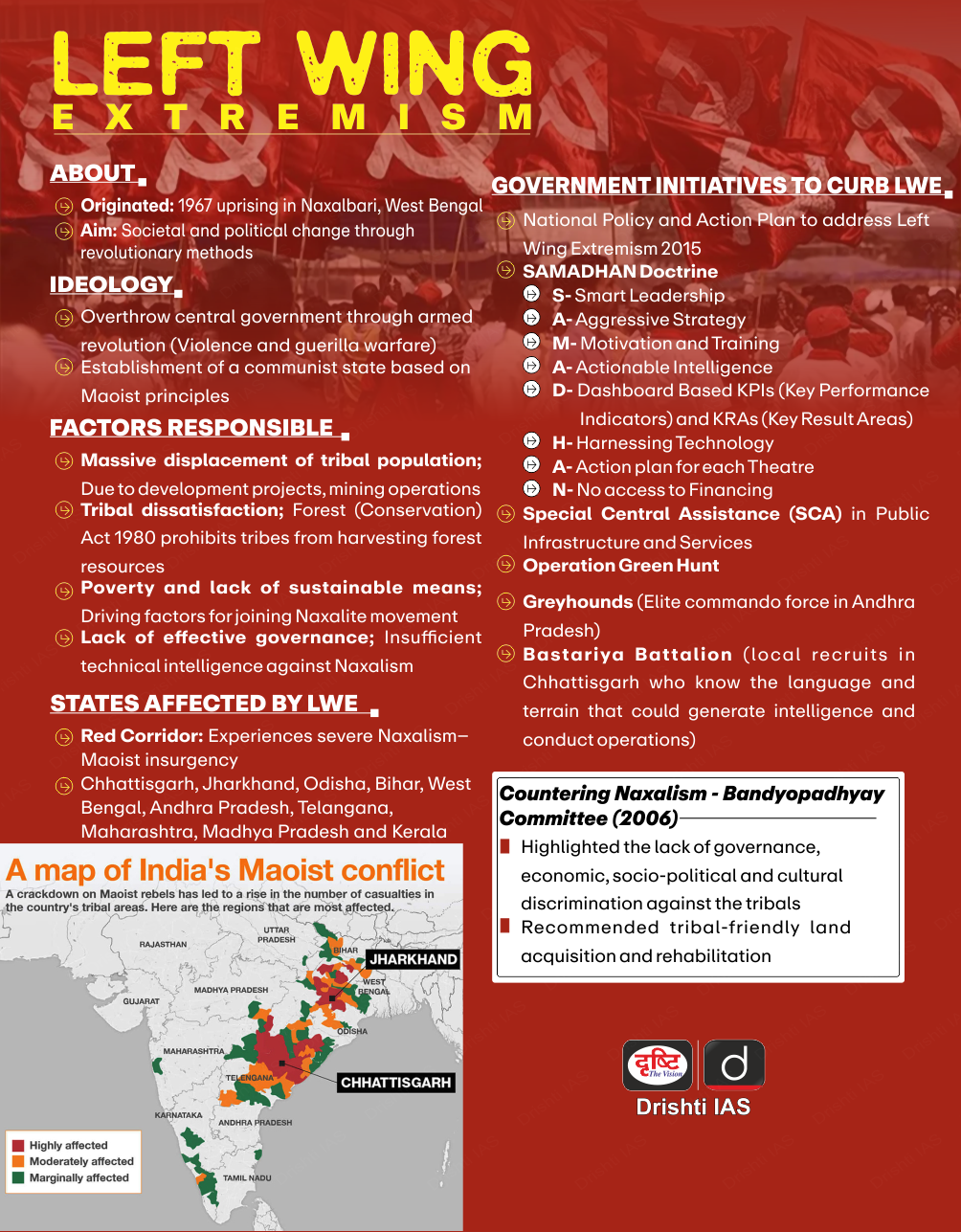Chhattisgarh
Operation Black Forest
- 23 May 2025
- 6 min read
Why in News?
Under Operation Black Forest, security forces scored a major success in their anti-Maoist campaign by killing 27 Naxals, including the top Maoist leader Nambala Keshav Rao, during an encounter in the Abujhmad region on the Chhattisgarh border between Narayanpur and Bijapur districts.
Key Points
Black Forest Operation
- About:
- Operation Black Forest marked the longest continuous anti-Naxal campaign, executed jointly by the Central Reserve Police Force (CRPF) and Chhattisgarh Police over a span of 21 days.
- The operation was launched in the vicinity of Karreguttalu Hill (KGH), a known Naxal stronghold situated along the Chhattisgarh–Telangana border, making it a strategically sensitive zone.
- The Ghalgam Forward Operating Base set up in 2022, functioned as the central command hub for the mission, enabling effective coordination and sustained operational momentum in the challenging terrain.
- The operation led to 54 arrests and 84 surrenders across Chhattisgarh, Telangana, and Maharashtra.
- Strategic Significance of the Operation:
- For the first time in three decades, a general secretary-level leader of the CPI-Maoist has been neutralised, marking a critical milestone in anti-Naxal operations.
- The removal of top leadership is likely to disrupt the Maoist organisational hierarchy, weakening their strategic coordination and communication channels.
- The success of the operation demonstrates enhanced collaboration between central and state forces, supported by actionable intelligence and logistical coordination across state boundaries.
- The rising number of Maoist surrenders and arrests indicates that support for their ideology and organisation is weakening, which could lead to lasting peace in areas affected by Left Wing Extremism.
- For the first time in three decades, a general secretary-level leader of the CPI-Maoist has been neutralised, marking a critical milestone in anti-Naxal operations.
Maoist Leader- Nambala Keshav Rao
- He served as the General Secretary of CPI-Maoist, holding the highest position in the insurgent leadership.
- He was widely known for his expertise in guerrilla warfare, including jungle combat tactics and Improvised Explosive Device (IED) making.
- He was the mastermind behind the 2010 Dantewada massacre, which resulted in the killing of 76 CRPF personnel.
| Read more: Anti-Maoist Operation at Kareguttalu Hill |
Government Measures to Counter Naxalism
- Security and Counterinsurgency Operations:
- Major Operations: Key campaigns such as Operation Steeplechase (1971) and Operation Green Hunt (2009) involved joint action by central and state forces, including elite CoBRA (Commando Battalion for Resolute Action) commandos, to dismantle Naxalite networks.
- Specialised Forces: Units like the Greyhounds in Andhra Pradesh and the Bastariya Battalion in Chhattisgarh were raised with active participation from tribal youth to ensure region-specific counterinsurgency effectiveness.
- Unified Command Mechanism (2010): This framework was established to promote inter-state coordination, ensuring unified response among LWE-affected states.
- SAMADHAN Strategy:
- A holistic framework adopted by the Ministry of Home Affairs to counter Naxalism with the following components:
- Smart leadership
- Aggressive strategy
- Motivation and training
- Actionable intelligence
- Dashboard-based KPIs
- Harnessing technology
- Action plans for specific zones
- No financial access to insurgents
- A holistic framework adopted by the Ministry of Home Affairs to counter Naxalism with the following components:
- Infrastructure Development:
- Road Requirement Plan-I (RRP-I): Launched in 2016, the Road Connectivity Project for LWE Affected Areas (RCPLWE) aims to improve road connectivity in areas impacted by LWE.
- Construction of Fortified Police Stations: As part of strengthening local law enforcement, several fortified police stations have been constructed in sensitive districts of the state under the Special Infrastructure Scheme (SIS).
- Skill Development and Employment Generation:
- ROSHNI Scheme: Focuses on skill development and employment-linked training for youth in LWE-affected districts.
- Establishment of ITIs: Industrial Training Institutes have been set up to enhance vocational skills and boost local employment.
- Socio-Economic and Developmental Initiatives:
- Forest Rights Act (2006): Recognizes the land and forest rights of tribal communities, addressing longstanding grievances and empowering local governance.
- Civic Action Programme (CAP): Aims to build trust between security forces and local populations through welfare activities and outreach.
- Aspirational Districts Programme (ADP): Launched in 2018, aims to transform LWE affected districts across health, education, infrastructure, and governance metrics.
- Data-Driven Governance via GIS Mapping:
- GIS-Based Planning: The government is leveraging GIS technology to map essential services—schools, banks, post offices, health centres, roads, and police stations—in LWE-affected regions, enabling targeted developmental and security interventions.
Red Corridor
- The Red Corridor is the region in the central, eastern and southern parts of India that experience severe Naxalism–Maoist insurgency.
- It includes the states of Chhattisgarh, Jharkhand, Odisha, Bihar, West Bengal, Andhra Pradesh, Telangana, Maharashtra, Madhya Pradesh and Kerala.



.jpg)




